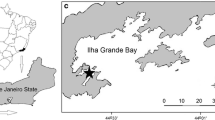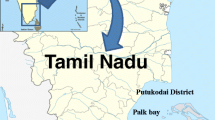Abstract
Two varieties of the carrageenophyte Kappaphycus alvarezii (Tungawan, TUNG; and Giant tambalang, GTAM) from Zamboanga Sibugay, Philippines were used to test the efficacy of Acadian Marine Plant Extract Powder (AMPEP) as source of nutrients for growth, and to determine if applications had any effect on the percent occurrence of an epiphytic infestation of the red alga Neosiphonia sp. at four different depths in the sea. Results showed that the use of AMPEP significantly (P < 0.05) increased the growth rate of both Kappaphycus varieties tested but decreased the percent occurrence of Neosiphonia sp. The percent occurrence of Neosiphonia sp. infection (6–50% at all depths) of both Kappaphycus varieties with AMPEP treatment was significantly lower than the controls (i.e., 10–75% at all depths). Both the growth rate of the cultivated seaweed and the percent occurrence of the epiphytes decreased as the cultivation depth increased. Plants dipped in AMPEP and suspended at the surface had the highest growth rates (i.e., 4.1%, TUNG; 3.1%, GTAM) after 45 days; those without AMPEP dipping had the highest percent occurrence of Neosiphonia infection (viz. 70–75%). The occurrence of Neosiphonia infestation was found to be correlated with changes in irradiance and salinity at the depths observed. The results suggested that both varieties of K. alvarezii used in this study have the fastest growth rate when grown immediately at the water surface. However, in order to minimize damage caused by the occurrence of epiphytic Neosiphonia, K. alvarezii should be grown within a depth range of 50–100 cm. These observations are important for the improved management of Kappaphycus for commercial farming. Furthermore, the use of AMPEP treatments for enhancement of growth and reduction deleterious Neosiphonia sp. infections is encouraging.

Similar content being viewed by others
References
Ask EI, Azanza RV (2002) Advances in cultivation technology of commercial eucheumatoid species: a review with suggestion for future research. Aquaculture 206:257–277
Bixler HJ, Porse H (2010) A decade of change in the seaweed hydrocolloids industry. J Appl Phycol. doi:10.1007/s10811-101-9529-3
Blunden G, Jenkins T, Yan-Wen L (1996) Enhanced leaf chlorophyll levels in plants treated with seaweed extract. J Appl Phycol 8:535–554
Cragie JS (2010) Seaweed extract stimuli in plant science and agriculture. J Appl Phycol. doi:10.1007/s10811-010-9560-4
Critchley AT, Largo D, Wee W, Bleicher L’honneur G, Hurtado AQ, Schubert J (2004) A preliminary summary on Kappaphycus farming and the impact of epiphytes. Jap J Phycol (Supplement) 52:231–232
Dawes CJ, Lluisma AO, Trono GC (1994) Laboratory and field growth studies of commercial strains of Eucheuma denticulatum and Kappaphycus alvarezii farmed in the Philippines. J Appl Phycol 6:21–24
Featonby-Smith BC, van Staden J (1983) The effect of seaweed concentrate on the growth of tomato plants in nematode-infested soil. Sci Hortic 20:137–531
Glenn EP, Doty MS (1990) Growth of seaweeds Kappaphycus alvarezii, K. striatum and Eucheuma denticulatum as affected by environment in Hawaii. Aquaculture 84:245–255
Hurtado AQ (2004) Effects of epiphytes on the productivity of Kappaphycus. Terminal report submitted to Degussa Texturant Systems (now Cargill). January, 66 pp
Hurtado AQ, Critchley AT (2006) Seaweed industry of the Philippines and the problem of epiphytism in Kappaphycus farming. In: Critchley, Phang, Ang (eds) Advances in seaweed cultivation and utilization in Asia. University of Malaya Maritime Research Centre, University of Malaya, 50603 Kuala Lumpur, pp 21–28
Hurtado AQ, Critchley AT, Bleicher-Lhonneur G (2006) Occurrence of Polysiphonia epiphytes in Kappaphycus farms at Calaguas Is., Camarines Norte, Philippines. J Appl Phycol 18:301–306
Hurtado AQ, Critchley AT, Trespoey A, Bleicher-Lhonneur G (2008) Growth and carrageenan quality of Kappaphycus striatum var. sacol grown at different stocking densities, duration of culture and depth. J Appl Phycol 20:551–555
Hurtado AQ, Yunque DA, Tibubos K, Critchley AT (2009) Use of Acadian marine plant extract powder from Ascophyllum nodosum in tissue culture of Kappaphycus varieties. J Appl Phycol 21:633–639
Jayaraj J, Norrie J, Punja ZK (2010) Commercial extract from the brown seaweed Ascophyllum nodosum reduces fungal diseases in greenhouse cucumber. J Appl Phycol. doi:10.1007/s10811-010-9547-1
Jayaraj J, Wan A, Rahman M, Punja ZK (2008) Seaweed extracts reduces foliar fungal disease on carrot. Crop Prot 27:1360–1366
Largo DB, Fukami F, Nishijima T, Ohno M (1995a) Laboratory induced development of the ice-ice disease of the farmed red algae Kappaphycus alvarezii and Eucheuma denticulatum (Solieriaceae, Gigartinales, Rhodophyta). J Appl Phycol 7:539–543
Largo DB, Fukami F, Nishijima T (1995b) Occasional bacteria promoting ice-ice disease in the carrageenan-producing red algae Kappaphycus alvarezii and Eucheuma denticulatum (Solieriaceae, Gigartinales, Rhodophyta). J Appl Phycol 7:545–554
Leach WL, Plunkett BA, Blunden G (1999) Reduction of nitrate leaching from soil treated with an Ascophyllum nodosum-based soil conditioning agent. J Appl Phycol 11:593
Lim JR, Porse H (1981) Breakthrough in the commercial culture of Eucheuma spinosum in Northern Bohol, Philippines. Proc Inter Seaweed Symposium 10:601–606
Lizzy Y, Coulomb C, Polian C, Coulomb PJ, Coulomb PO (1998) Seaweed and mildew: what does the future hold? Laboratory test have produced encouraging results L’algue face au mildiou: quell avenir? Des resultas de laboratorie tres encourageants. Phytoma 508:29–30
Loureiro RR, Reis RP, Critchley AT (2009) In vitro cultivation of three Kappaphycus alvarezii (Rhodophyta, Areschougiaceae) variants (green, red and brown) exposed to a commercial extract of the brown alga Ascophyllum nodosum (Fucaceae, Ochrophyta). J Appl Phycol 22:101–104
Ohno M, Nang HQ, Hirase ST (1996) Cultivation and carrageenan yield and quality of Kappaphycus alvarezii in the waters of Vietnam. J Appl Phycol 8:431–437
Paula EJ, Pereira RTL, Ohno M (2002) Growth rate of the carrageenophyte Kappaphycus alvarezii (Rhodophyta, Gigartinales) introduced in subtropical waters of Sao Paulo State, Brazil. Phycol Res 50:1–9
Rayorath P, Khan W, Palanisamy R, MacKinnon SL, Stefanova R, Hankins SD, Critchley AT, Prithiviraj B (2008) Extracts of the brown seaweed Ascophyllum nodosum induce gibberellic acid (GA3)-independent amylase activity in barley. J Plant Growth Regul 27:370–379
Rayorath P, Mundaya JN, Farid A, Wajahatullah K, Ravishankar P, Hankins SD, Critchley AT, Prithiviraj B (2007) Rapid bioassays to evaluate the plant growth promoting activity of Ascophyllum nodosum (L.) Le Jol. using a model plant, Arabidopsis thaliana (L) Heynh. J Appl Phycol 20:423–429
Robertson-Anderson DV, Leitao D, Bolton JJ, Anderson RJ, Njobeni A, Ruck K (2006) Can kelp extract (KELPAK) be useful in seaweed mariculture? J Appl Phycol 18:315–321
Stephenson WM (1966) The effect of hydrolyzed seaweed on certain plant pests and diseases. Proc Internat Seaweed Symposium 5:405–415
Ugarte RA, Sharp G, Moore B (2006) Changes in the brown seaweed Ascophyllum nodosum (L. Le Jol.) plant morphology and biomass produced by cutter rakes harvests in southern New Brunswick, Canada. J Appl Phycol 18:351–359
Vairappan CS (2006) Seasonal occurrences of epiphytic algae on the commercially cultivated red alga Kappaphycus alvarezii (Solieriaceae, Gigartinales, Rhodophyta). J Appl Phycol 18:611–617
Vairappan CS, Chung CS, Hurtado AQ, Soya FE, Bleicher-Lhonneur G, Critchley A (2008) Distribution and symptoms of epiphyte infection in major carrageenophyte-producing farms. J Appl Phycol 20:477–483
Wu Y, Jenkins T, Blunden G, von Mende N, Hankins SD (1998) Suppression of fecundity of the root-knot nematode, Meloidogyne javanica, in monoxenic cultures of Arabidopsis thaliana treated with alkaline extract of Ascophyllum nodosum. J Appl Phycol 10:91–94
Zhang J, Ervin EH, Schmidt RE (2003) Physiological effects of liquid applications of a seaweed extract and a humic acid on creeping bentgraa. J Amer Hort Sci 128:492–496
Acknowledgment
The SEAFDEC/AQD authors would like to thank Andy Boy and Onyok Gaitan for their technical assistance during samplings.
Author information
Authors and Affiliations
Corresponding author
Rights and permissions
About this article
Cite this article
Borlongan, I.A.G., Tibubos, K.R., Yunque, D.A.T. et al. Impact of AMPEP on the growth and occurrence of epiphytic Neosiphonia infestation on two varieties of commercially cultivated Kappaphycus alvarezii grown at different depths in the Philippines. J Appl Phycol 23, 615–621 (2011). https://doi.org/10.1007/s10811-010-9649-9
Received:
Revised:
Accepted:
Published:
Issue Date:
DOI: https://doi.org/10.1007/s10811-010-9649-9




